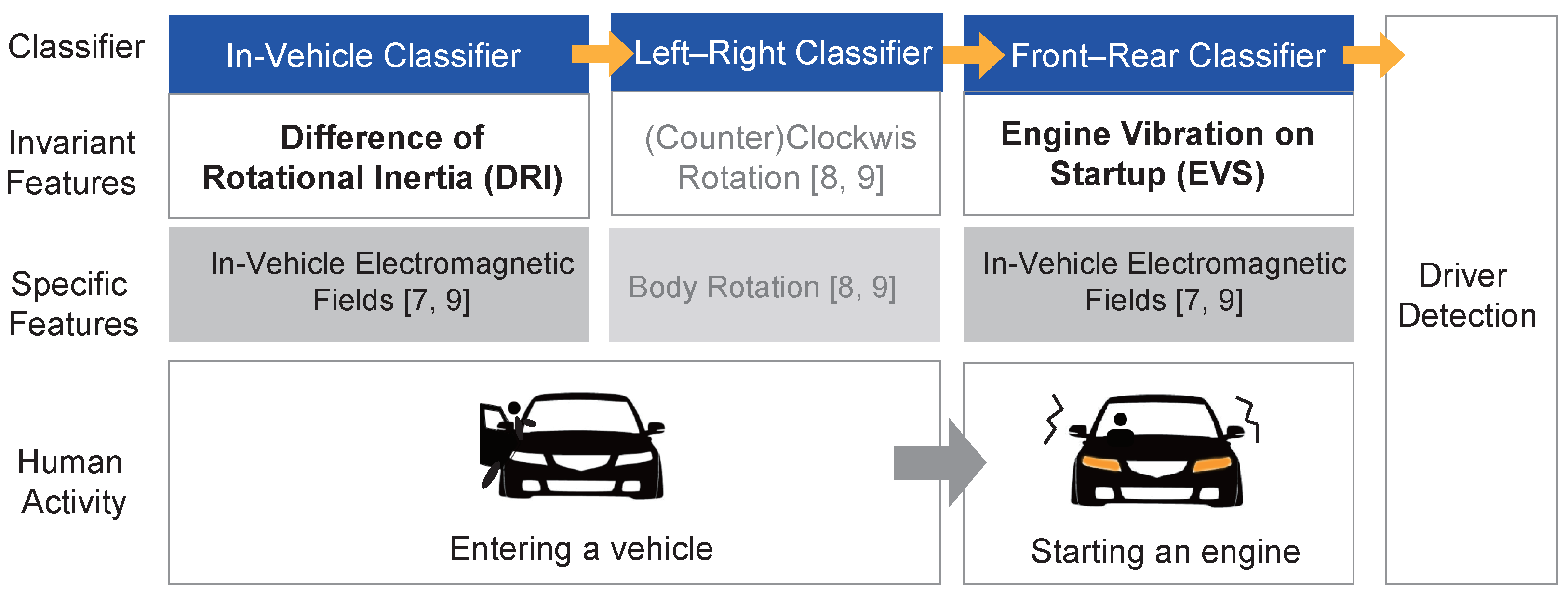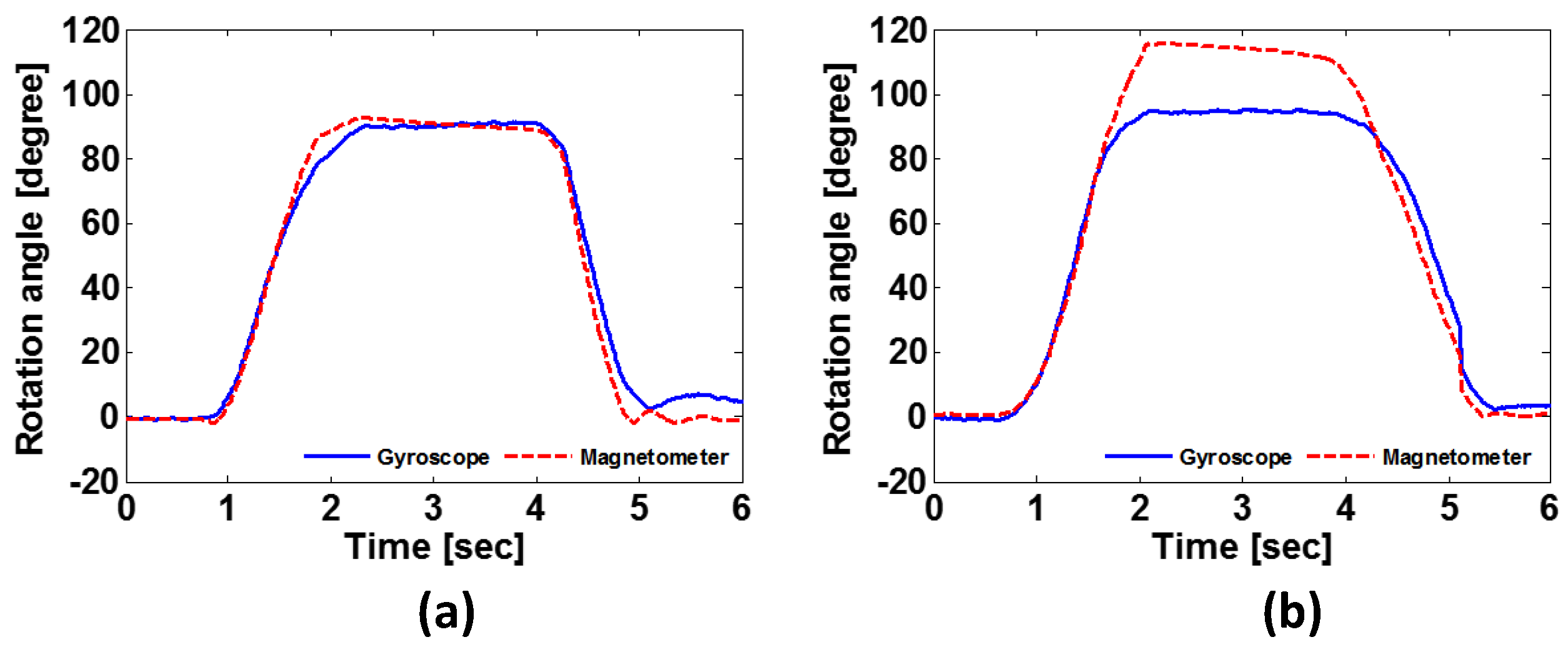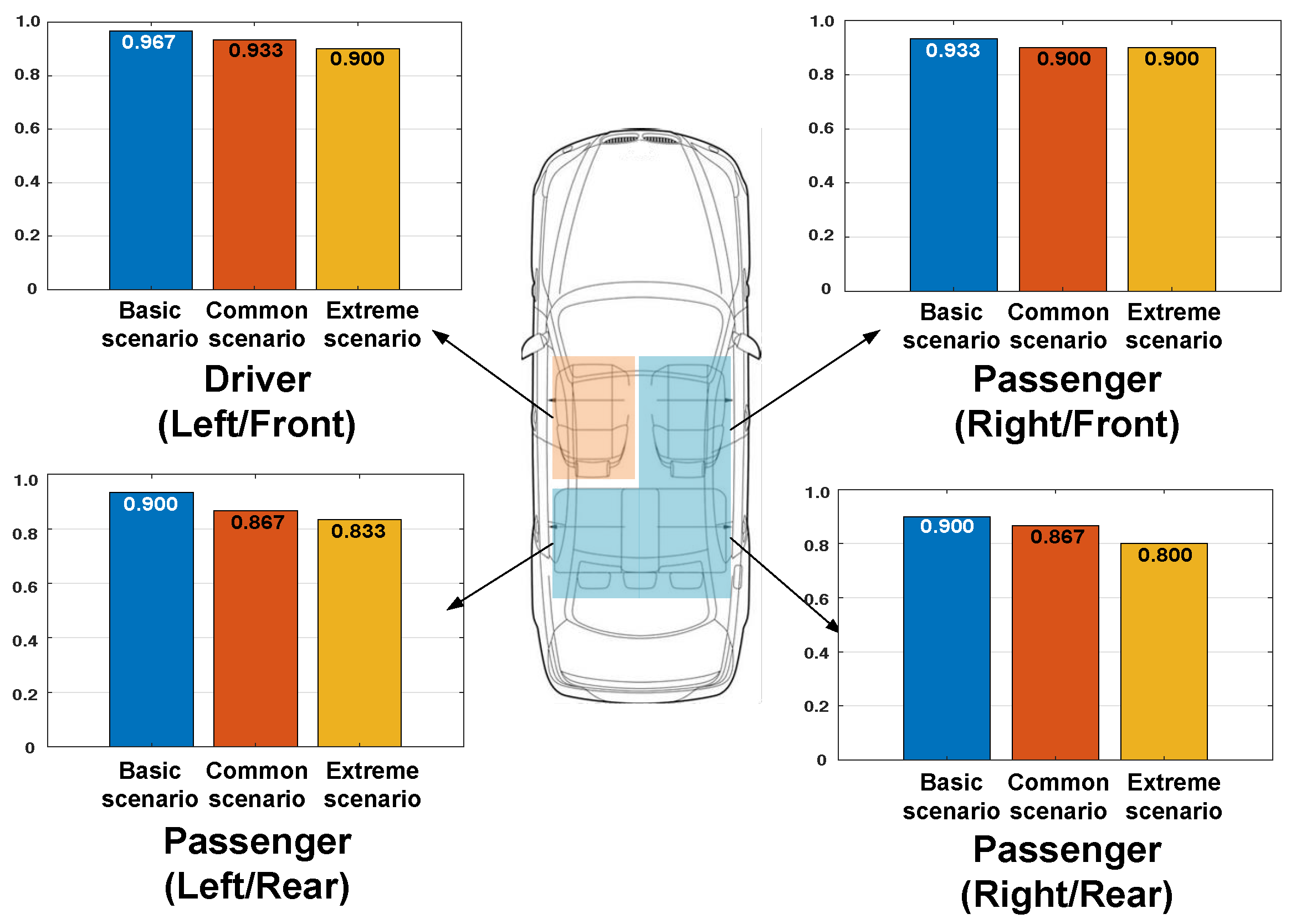Accurate Driver Detection Exploiting Invariant Characteristics of Smartphone Sensors
Abstract
:1. Introduction
2. The Proposed System
2.1. System Overview
2.2. Difference of Rotational Inertia
2.3. Engine Vibrations on Startup
- ,
- , and
- .
- It reads accelerometer and magnetometer readings for a predefined duration of time, which is set to 2 s in our experiments.
- It passes the accelerometer readings through a pre-filter to extract EVS within a frequency band of 8~12 Hz while removing interferences and noises.
- It determines the similarity between the filtered EVS and the reference pattern by calculating a cross-correlation coefficient.
- If the similarity is less than 0.6, it goes back to step 1.
- Otherwise, it analyzes the magnitude of the EMF to distinguish between the front and rear.
3. Performance Evaluation
3.1. Experimental Setup
- Basic scenario:
- participants did not manipulate their smartphones when entering, thus incurring only three events (standing, sitting, and engine-starting).
- Common scenario:
- participants were allowed to use their smartphones while entering a vehicle (e.g., texting and phone call), which generates noise that could distort/override required sensory features.
- Extreme scenario:
- participants were allowed to perform unexpected actions (e.g., swinging while walking, and shaking) that are less likely to be observed during vehicle-riding events, to produce a significant amount of noise.
3.2. Performance of In-Vehicle Classification
3.3. Performance of Front-Rear Classification
3.4. Performance of Driver Detection
3.5. Energy Consumption
3.6. Discussion
4. Conclusions
Author Contributions
Funding
Conflicts of Interest
References
- National Safety Council. Annual Estimate of Cell Phone Crashes 2013; National Safety Council: Itasca, IL, USA, 2015. [Google Scholar]
- Box, S. CELL PHONE TASK Risk of Crash or Near Crash event Light Vehicle/Cars. 2009. Available online: https://www.arrivealive.co.za/documents/7-22-09-vtti-press_release_cell_phones_and_driver_distraction.pdf (accessed on 9 June 2019).
- National Highway Traffic Safety Administration. Available online: http://www.nhtsa.gov/ (accessed on 9 June 2019).
- Governors Highway Safety Association, Distracted Driving Laws. 2016. Available online: http://www.ghsa.org/ (accessed on 9 June 2019).
- Wang, Y.; Yang, J.; Liu, H.; Chen, Y.; Gruteser, M.; Martin, R.P. Sensing vehicle dynamics for determining driver phone use. In Proceeding of the 11th Annual International Conference on Mobile Systems, Applications, and Services, Taipei, Taiwan, 25–28 June 2013; ACM: New York, NY, USA, 2013. [Google Scholar] [Green Version]
- Chu, H.L.; Choudhury, R.R. In-vehicle driver detection using mobile phone sensors. In Proceedings of the ACM MobiSys, Washington, DC, USA, 28 June–1 July 2011. [Google Scholar]
- Cheng, B.; Jian, X.; Li, X.-Y. TEXIVE Detecting Drivers Using Personal Smart Phones by Leveraging Inertial Sensors. arXiv 2013, arXiv:1307.1756. [Google Scholar]
- Ahn, D.H.; Park, H.; Hwang, S.; Park, T. Reliable identification of vehicle-boarding actions based on fuzzy inference system. Sensors 2017, 17, 333. [Google Scholar] [CrossRef] [PubMed]
- Park, H.; Ahn, D.H.; Park, T.; Shin, K.G. Automatic Identification of Driver’s Smartphone Exploiting Common Vehicle-Riding Actions. IEEE Trans. Mob. Comput. 2018, 17, 265–278. [Google Scholar] [CrossRef]
- Chu, H.; Raman, V.; Shen, J.; Kansal, A.; Bahl, V.; Choudhury, R.R. I am a smartphone and I know my user is driving. In Proceedings of the COMSNETS, Bangalore, India, 6–10 January 2014. [Google Scholar]
- Cheng, B.; Jian, X.; Li, X.-Y.; Mao, X.; Wang, Y.; Li, F. You’re Driving and Texting: Detecting Drivers Using Personal Smart Phones by Leveraging Inertial Sensors. In Proceedings of the MobiCom’13, Miami, FL, USA, 30 September–4 October 2013. [Google Scholar]
- Kok, M.; Schön, T.B. Magnetometer calibration using inertial sensors. IEEE Sens. J. 2016, 16, 5679–5689. [Google Scholar] [CrossRef]
- Renaudin, V.; Afzal, M.H.; Lachapelle, G. Complete triaxis magnetometer calibration in the magnetic domain. J. Sens. 2010, 2010, 967245. [Google Scholar] [CrossRef]
- Nikolic, D.; Mureşan, R.C.; Feng, W.; Singer, W. Scaled correlation analysis: A better way to compute a cross-correlogram. Eur. J. Neurosci. 2012, 35, 742–762. [Google Scholar] [CrossRef] [PubMed]
- Chan, Y.H. Biostatistics 104: Correlational analysis. Sing. Med. J. 2003, 44, 614–619. [Google Scholar]
- Shapiro, S.S.; Martin, B.W. An analysis of variance test for normality (complete samples). Biometrika 1965, 52, 591–611. [Google Scholar] [CrossRef]
- Mann, H.B.; Whitney, D.R. On a test of whether one of two random variables is stochastically larger than the other. Ann. Math. Stat. 1947, 18, 50–60. [Google Scholar] [CrossRef]
- Alfred, D. A tutorial in logistic regression. J. Marriage Fam. 1995, 57, 956–968. [Google Scholar]











| Subject | Sex | Age | Height | Weight |
|---|---|---|---|---|
| P1 | M | 30 | 179 | 90 |
| P2 | M | 31 | 181 | 85 |
| P3 | M | 25 | 173 | 80 |
| P4 | F | 26 | 160 | 51 |
| Condition | Summary Statistics | Shapiro–Wilk W Test | Mann–Whitney U Test | ||||||
|---|---|---|---|---|---|---|---|---|---|
| Scenario | Environment | Min | Median | Max | Mean | Std. Dev. | W | Prob < W | p-Value |
| Basic | Office chair | 0.76 | 15.90 | 69.94 | 19.19 | 13.61 | 0.898 | <0.0001 | <0.0001 |
| Vehicle | 15.05 | 33.05 | 53.98 | 32.66 | 6.74 | 0.989 | 0.0626 | ||
| Common | Office chair | 5.03 | 22.59 | 38.44 | 22.85 | 6.07 | 0.982 | 0.0033 | <0.0001 |
| Vehicle | 6.78 | 42.81 | 79.53 | 44.23 | 9.88 | 0.888 | <0.0001 | ||
| Extreme | Office chair | 2.85 | 27.56 | 78.18 | 29.99 | 12.89 | 0.957 | <0.0001 | <0.0001 |
| Vehicle | 25.41 | 42.58 | 93.72 | 45.71 | 12.49 | 0.944 | <0.0001 | ||
© 2019 by the authors. Licensee MDPI, Basel, Switzerland. This article is an open access article distributed under the terms and conditions of the Creative Commons Attribution (CC BY) license (http://creativecommons.org/licenses/by/4.0/).
Share and Cite
Ahn, D.; Park, H.; Shin, K.; Park, T. Accurate Driver Detection Exploiting Invariant Characteristics of Smartphone Sensors. Sensors 2019, 19, 2643. https://doi.org/10.3390/s19112643
Ahn D, Park H, Shin K, Park T. Accurate Driver Detection Exploiting Invariant Characteristics of Smartphone Sensors. Sensors. 2019; 19(11):2643. https://doi.org/10.3390/s19112643
Chicago/Turabian StyleAhn, DaeHan, Homin Park, Kyoosik Shin, and Taejoon Park. 2019. "Accurate Driver Detection Exploiting Invariant Characteristics of Smartphone Sensors" Sensors 19, no. 11: 2643. https://doi.org/10.3390/s19112643
APA StyleAhn, D., Park, H., Shin, K., & Park, T. (2019). Accurate Driver Detection Exploiting Invariant Characteristics of Smartphone Sensors. Sensors, 19(11), 2643. https://doi.org/10.3390/s19112643






